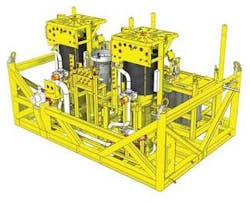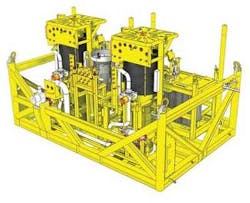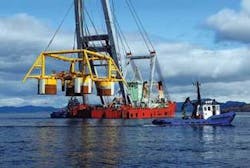Nick Terdre, Contributing Editor
Statoil is well under way with its Tyrihans oil/gas/condensate project in the Norwegian Sea off mid-Norway. The production templates for the field, which is being developed with subsea wells tied back to the Kristin floating production platform, were installed this summer, and production drilling is to start next year. Field startup is scheduled for summer 2009.
Tyrihans was discovered in 1983 as Statoil’s first find on the Halten Bank. But a production opportunity only materialized when infrastructure had been installed in the area to serve the Åsgard field development in the late 1990s and Kristin in the current decade. The field’s commerciality was enhanced when an appraisal well drilled in 2002 led to a 25% increase in the reserves estimate. In the plan for development and operation (PDO) these are estimated at 182 MMbbl of liquids, comprising both oil and condensate, and 34.8 bcm (1,229 tcf) of gas.
The reserves are in two separate structures: Tyrihans South is an oil field with a gas cap, while Tyrihans North is a gas/condensate field with a thin underlying oil zone.
Statoil, which is targeting 55% recovery from its Norwegian subsea fields, has brought the full range of improved recovery techniques to bear on Tyrihans, according to project director Ståle Gjersvold. These include multilateral wells, downhole integrated fiber-optic systems, remote operation of subsea wells and facilities with the backing of onshore support, subsea injection of raw sea water, direct electrical heating of the production pipeline, and possibly subsea compression in the tail-end phase.
While the company expects to reach the recovery goal with respect to Tyrihans South, the thin oil zone in the northern reservoir, which is expected to be about 14 m (46 ft) thick, presents particular difficulties. Recovery from this zone is at present estimated at only 6%. The oil will be produced before the gas, in a phase which is expected to last three to four years.
Plateau oil production will be 55,000 b/d for oil and 13 MMcm/d (459 MMcf/d) for gas. Altogether, 12 wells will be drilled, including eight oil producers and one gas producer. Both gas and water will be injected through two gas injection wells and one water injector. Water injection is expected to improve recovery 10% or more.
The gas injectors, which will be drilled directly into the two reservoirs, each will be housed on one of the production templates, of which three, B, C, and D, are on Tyrihans South and one, A, on Tyrihans North. The water injector will be on its own template which will be on the ‘saddle’ between the two reservoirs, thus providing pressure support for both.
The subsea equipment - templates, trees and controls - is being supplied by FMC under its frame agreement with Statoil.
The wellstream from the subsea wells will be transported to Kristin through a single multi-phase pipeline, which will have a diameter of 18 in. (45.7 cm), though this narrows to 16 in. (40.6 cm) close to the riser at the platform. The pipeline is connected to template D by a rigid spool. The other templates are connected individually to the same template by flexible spools.
The pipeline employs carbon steel with a 3-mm (0.118-in.) liner of 316L stainless steel. This was bonded mechanically to the inner wall of the line by a proprietary technique developed by Butting, which supplied the line-pipe. A 57-mm (2 1/4-in.) outer layer of polypropylene provides thermal insulation. Bredero Shaw was responsible for the coating.
Statoil decided against trenching the line to avoid the risk of upheaval buckling and subsequent damage to the line, according to Torstein Vinterstø, project manager, subsea. The pipeline is therefore laid on the seabed so that thermal expansion can occur in a lateral direction without causing damage.
The line is fitted with a direct electrical heating (DEH) system consisting of an 85-mm (3.346-in.) heating cable attached to the outside of the pipeline. The system, which is capable of heating the pipeline contents to 23°C, will be used both during re-start operations after a production shutdown and during the tail-end phase of production, when the volume of the pipeline contents will be insufficient to maintain the temperature at an adequate level.
Statoil helped pioneer DEH technology and has used it on other fields such as Huldra in the North Sea and Åsgard. However, the Tyrihans application represents the longest step-out per se and the longest step-out for a multi-phase line. Qualifying the cable for life-of-field application cost NKr 30 million ($5.15 million) and took three years. Getting the insulation material right posed a particular challenge. The DEH system is being supplied by Nexans Norway.
The heating cable has to be protected against the impacts of trawl-boards and dropped objects, something which is achieved with a mechanical protection system (MPS) made of plastic. The MPS consists of a bottom profile that is laid on the pipeline and within which the cable is laid, and an upper profile that locks on top. The MPS/cable assembly is held in place by straps.
Pipelay contractor Acergy Offshore also faced unusual challenges, an unprecedented combination of S-lay, 316L clad line-pipe, and a DEH system not attempted anywhere previously. In addition to welding together the carbon steel sections, the liner ends had to have a root weld. Then, the cable/MPS assembly had to be applied and strapped in place. When lay-bargeAcergy Piper started work in mid-June, it was laying 600 m (1,968 ft) of pipeline a day. However, the lay barge crew was expected to go through a learning process, with the lay rate eventually improving to around 1,000 m (3,280 ft) or more per day, according to Gjersvold.
Subsea injection of raw seawater
Gas for injection and also for gas-lift in the wells will be provided from the Åsgard B platform via a 42-km (26-mi), 10-in. (254-mm) pipeline installed by layshipAcergy Falcon in June. Statoil decided to also use water injection as Åsgard B’s capacity to supply injection gas is limited and the gas is costly.
Water injection should bring the benefits of stabilizing the oil zone in the southern reservoir and of equalizing the pressure difference between the two reservoirs. Raw seawater will be injected through a seabed pumping station, the first time Statoil has used this new technology and only the second application of such a system.
The injection station will consist of a standard FMC template housing a manifold, a pump cassette with two pumps supplied by Aker Kværner, and the injection well. With the two pumps running in parallel, the design injection capacity is 88,000 b/d of oil, but Statoil hopes to achieve up to 100,000 b/d. This primarily depends on reservoir properties and how much power is lost in transmission, Vinterstø says.
Power will be supplied from Kristin at 2.5 MW to each pump and stepped down on the field from 22 kV to 6.6 kV - the first time Statoil has used subsea transformers. The Tyrihans project has coordinated closely with the Tordis project for subsea water separation and injection. Tordis is due onstream in October. The critical component for the Tyrihans subsea water injection system is the electrical couplers, says Vinterstø. It is essential to prevent the ingress of seawater into the pump motors and the electrical system. A careful choice also has to be made on the materials for the pump components that will be in contact with seawater. Before injection, the seawater will be passed through a filtration system to remove extraneous objects.
By avoiding the need for a pipeline from the host platform and for accommodating the pump on the platform, the subsea solution provides savings on the order of NOK 200-300 million ($34.34 million-$51.51 million), according to Vinterstø. Water injection is scheduled to start in 2010. The water injection station and template will be installed in 2009.
Drilling and smart completions
Drilling is due to start in early 2008 using theTransocean Arctic semisubmersible and will continue until about 2011. The producers all will have long horizontal sections, with 1,500-1,900 m (4,921-6,233 ft) sections in the reservoir. Seven of them will be dual-laterals. Three wells are due to be onstream at startup.
The oil wells will be fitted with DIACS completions, enabling different zones to be produced or shut in as desired. Downhole conditions will be monitored using sensors transmitting data in real time via fiber-optic cable to the Kristin platform, from which the Tyrihans facilities will be controlled, and onward to an onshore support center at Stjørdal outside Trondheim.
Kristin was chosen over Åsgard B as the host because it offers more convenience in phasing in Tyrihans. The topsides modifications also are easier as it was possible to carry out preparatory work while the platform was in the yard. A 330-ton (299-metric-ton) reception module for Tyrihans is scheduled for installation on Kristin in 2008 by Saipem crane-bargeS7000.
Tyrihans is expected to remain in production for 21 years. At the end, subsea compression may be used to boost the wellstream. Tie-in points are installed on the pipeline to enable the flow to be diverted to a compression station.
New template installation technique
Statoil faced a problem installing the Tyrihans production templates, according to subsea installation manager Ole Jørgen Johansen. The templates are not only heavy, weighing around 250 metric tons (275.58 tons) each, but also are large structures, measuring 25 x 25 x 13 m (82 x 82 x 42.65 ft). With the exit from the North Sea of medium-capacity construction vessels likeMaxita and Semis 1 and 2, the company was faced with footing a large bill for one of the top-of-the-range heavy-lifters such as Hermod or S7000.
Sheerlegs craneUglen ‘parks’ one of the Tyrihans production templates on the seabed outside Trondheim, ready for collection by construction vessel Botnica. (Photo: Geir Otto Johansen/Statoil)
Instead, it developed a method whereby the templates were “parked” on the seabed in 55 m (180.45 ft) of water in the fjord near Trondheim byUglen, a sheerlegs crane restricted to near-shore work. Then, each template in turn was winched up and suspended 30-40 m (98-131 ft) beneath the hull of Subsea 7’s Botnica construction vessel and towed to the field underwater. A specially supplied winch from Karmøy Winch was installed on Botnica for the purpose, with its wires deployed through the vessel’s moonpool.
Being able to move only at a modest 3-4 knots and then only in significant wave heights up to 4 m (13 ft), the vessel took two to three days to transport each template to the field.
New vessels under construction will fill the current gap in subsea construction capacity in the North Sea. One is Acergy’sSkandi Acergy, which, with a 400-ton (363-metric-ton) crane, would have the capacity to install the Tyrihans templates. However, the new method offers an additional option for future installation operations.






